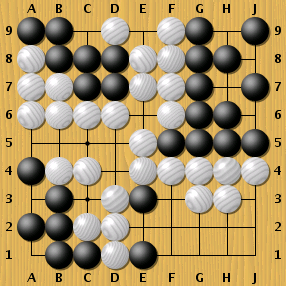 Go strategy and tactics
Go strategy and tactics  Life and death
Life and death
Life and death
A key concept in the tactics of Go, though not part of the rules, is the classification of groups of stones into alive, dead or unsettled.
At the end of the game, groups that cannot avoid being captured during normal play are removed as captures. These stones are dead. Groups can reach this state much earlier during play; a group of stones can quickly run out of options so that further play to save them is fruitless, or even detrimental. Similarly, further play to kill such a group is often of no benefit (except when securing liberties for an adjacent group), since if it remains on the board at the end of the game it is captured anyway. Thus groups can be considered "dead as they stand", or just dead, by both sides during the course of the game.
Groups enclosing an area completely can be harder to kill. Normally, when a play causes an area completely enclosed by the opponent to become filled, the group filling the area is captured since it has no remaining liberties (such a play is called "suicide"). Only if the last play inside the area would kill the enclosing group, thus freeing one or more liberties for the group that filled the space, can the play be considered. This can only be achieved if the liberties on the outside of the enclosing group have been covered first. Thus, enclosing an area of one or more liberties (called an eye) can make the group harder to kill, since the opponent must cover all of its external liberties before covering the final, internal liberty.

From this, it is possible to create groups that cannot be killed at all. If a group encloses two or more separate areas (two or more eyes), the opponent cannot simultaneously fill both of them with a single play, and thus can never play on the last liberty of the group. Such a group, or a group that cannot be prevented from forming such an enclosure, is called alive.
Groups which are not definitely alive nor definitely dead are sometimes called unsettled groups. Much of the tactical fighting in Go focuses on making one's own groups live, by ensuring they can make two eyes, and on making the opponent's groups die, by denying them two eyes.
Reading
Determining?ahead of time whether a group is currently alive, dead, or unsettled, requires the ability to extrapolate from the current position and imagine possible plays by both sides, the best responses to those plays, the best responses to those responses, and so on. This is called reading ahead, or just reading, and it is a skill that grows with experience. Many players study books of life and death problems to increase their skill at reading more and more complicated positions.
In general, go players refer to analysis of positions as reading. One major purpose of reading is to be sure that a local position can be neglected for a while. For instance, a player may be able to make gains by playing for a certain patch of territory. Yet, this play may be worth only a few points, and thus deemed unnecessary, depending on the state of the game. With confidence in one's reading, it becomes much easier to set priorities and switch around the board (see sente). Not changing gears at the correct time can be a loss of opportunity.
